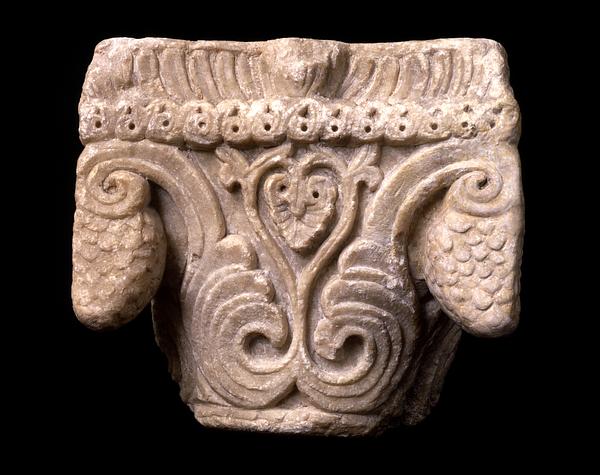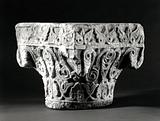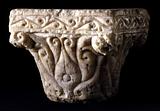Three capitals, alabaster
Syria, Raqqa; c. 800
H: 32 cm (35/1986)
H: 25.5 cm (1/2001)
H 24.5 cm (2/2001)
All three capitals are indebted to the classical idiom of Antiquity, but reflect a further development of classical motifs and a new form of stylization that was characteristic of the Abbasids.
The capitals come from the area around the Syrian city of Nikephorion, which was conquered in 639 by Muslim forces and renamed Raqqa. The city experienced its greatest expansion under the Abbasid caliph Harun al-Rashid when he made it the capital of the caliphate between 796 and 808 and built an enormous palace complex.
The cross on the latest capital (2/2001) shows that Islam was not the only religion that was tolerated in Raqqa, where churches, monasteries, and a bishopric were found as late as the 12th century. This capital is an example of the beveled style, where the move away from classical vegetal ornaments towards an abstract idiom was complete. It is difficult to determine here what the motif is and what forms the background. Although the completely new beveled style was developed under the Muslims in this period, the capital shows that it could also be used by followers of other religions in the region.
Inv. no. 35/1986, 1/2001 & 2/2001
Published in:
35/1986
Sotheby’s London, 15/10-1986, lot 128;
Art from the World of Islam. 8th-18th century, Louisiana, Humlebæk 1987, cat.no. 2;
Kjeld von Folsach: Islamic art. The David Collection, Copenhagen 1990, cat.no. 271;
Kjeld von Folsach, Torben Lundbæk and Peder Mortensen (eds.): Sultan, Shah and Great Mughal: the history and culture of the Islamic world, The National Museum, Copenhagen 1996, cat.no. 63;
Kjeld von Folsach: Art from the World of Islam in The David Collection, Copenhagen 2001, cat.no. 384;
1/2001
Drouot- Richelieu, Paris, 20/5-2000, lot 144;
2/2001
Drouot- Richelieu, Paris, 20/5-2000, lot 147;
Sheila S. Blair and Jonathan M. Bloom (eds.): Cosmophilia. Islamic Art from the David Collection, Copenhagen, McMullen Museum of Art, Boston College, Boston 2006, cat.no. 81;
Mattia Guidetti: In the shadow of the church: the building of mosques in early medieval Syria, Leiden [2017], pl. 7;





